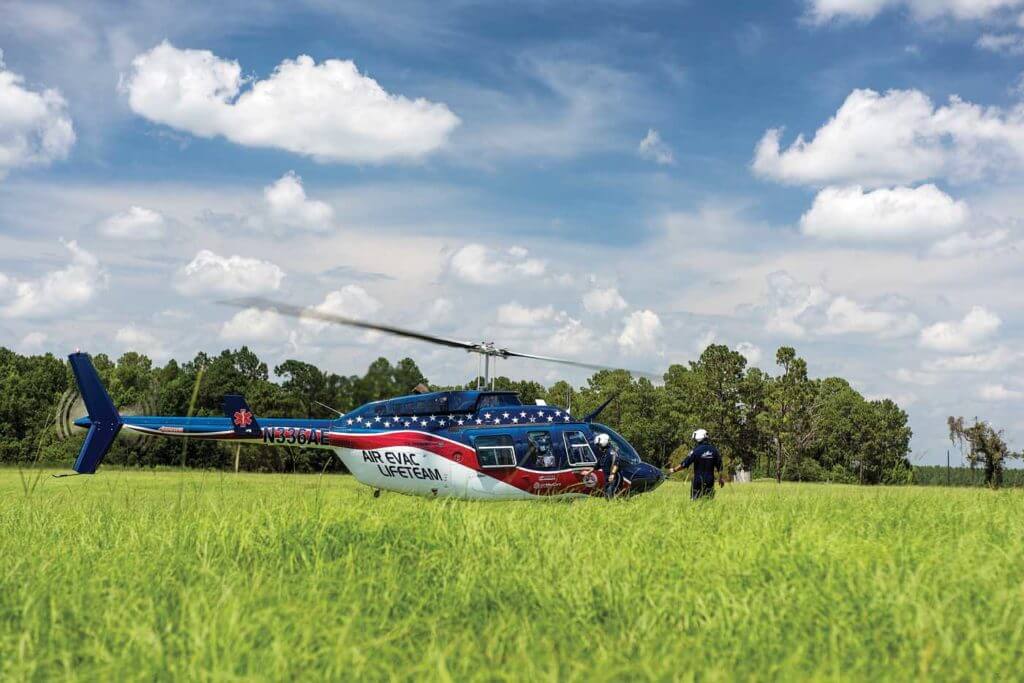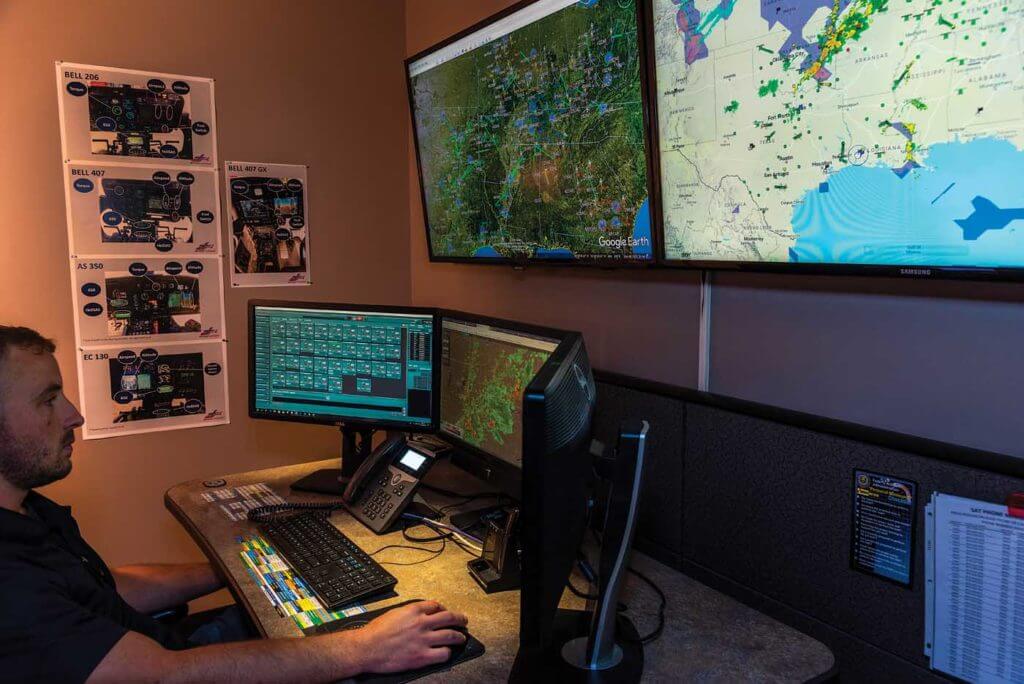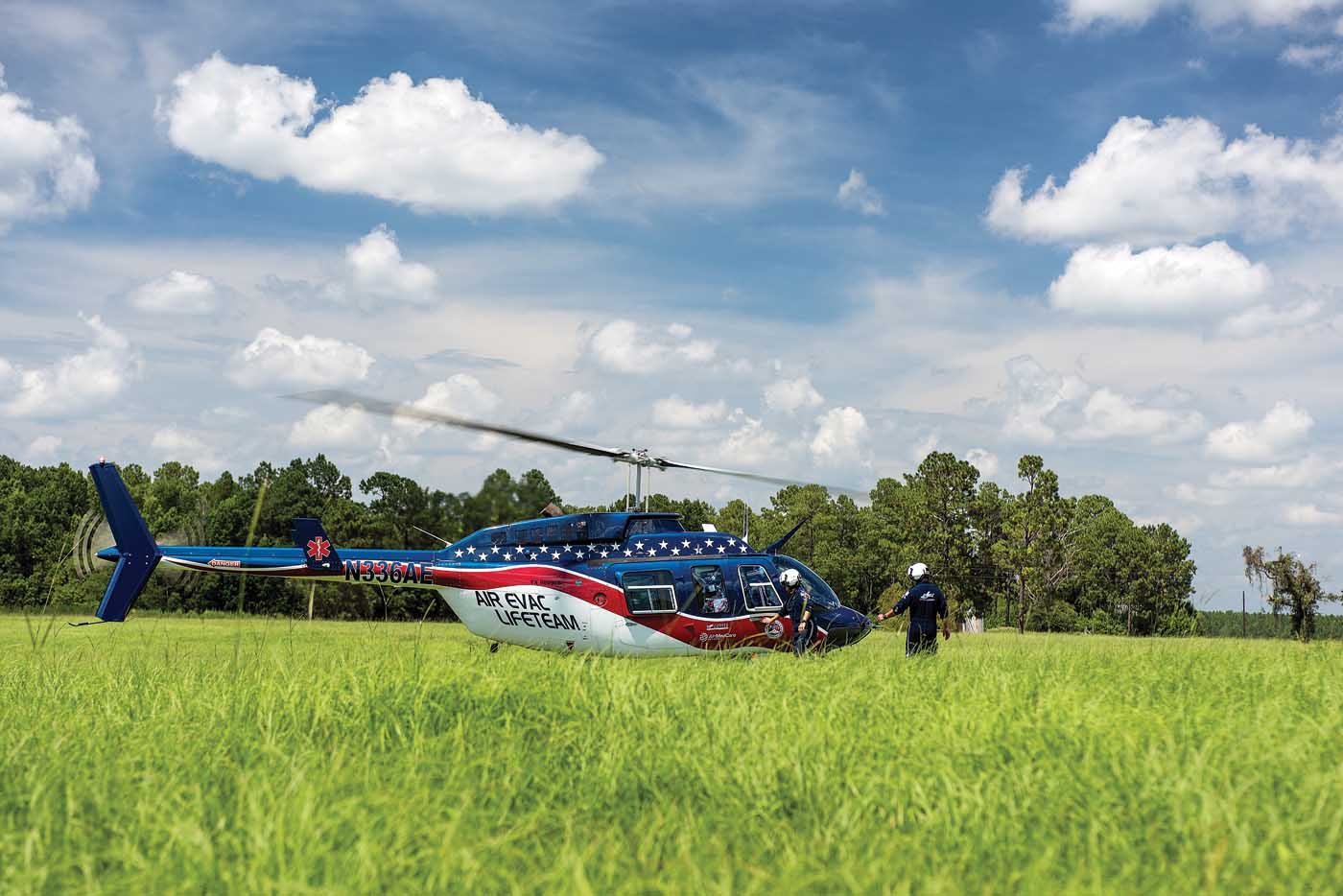When the pilot of an Air Evac Lifeteam helicopter suffered an in-flight medical emergency on Jan. 12, 2018, two things on board the Bell 206L LongRanger helped achieve a successful outcome. The first was a recently installed Genesys HeliSAS stability augmentation system and autopilot, which kept the aircraft stable until the pilot recovered enough faculties to land in an open field. The second was the high-functioning team of flight paramedic Lane Abshire and flight nurse Tara Coupel, whose refusal to give up was just as instrumental in getting the helicopter safely to the ground.
We shared their incredible story earlier this year in the Winter issue of Vertical 911 (now Vertical Valor), where we also described the training that Air Evac developed to cope with similar events in the future. Now, Air Evac wants to share its training tools and insights with the industry so that other organizations can likewise prepare for the rare but potentially catastrophic emergency of pilot incapacitation. The company has developed a 30-minute video that shows one of the specialists in its operations control center (OCC) talking a crewmember through an approach to an airport in a flight simulator, culminating in a successful run-on landing. Available to other flight programs upon request, the video showcases the clear, robust guidance that Air Evac’s OCC specialists developed through months of testing and refinement.
As Air Evac president Seth Myers explains in the video, following the 2018 event in Kinder, Louisiana, Air Evac asked from a safety management system (SMS) perspective, “What could we do to manage this risk in the future? Because frankly, we weren’t prepared, and as we’ve heard from many others in the industry, they are not prepared either for this.” Now, going on two years later, Air Evac’s OCC specialists are experts on the avionics and autopilot systems in the company’s fleet. They have cockpit diagrams they can reference, and extensive practice in getting non-pilots to a location where their odds of a survivable landing are greatly increased. By sharing an example of how that works, Myers said, Air Evac wants to help other organizations devise their own training to similarly manage the risk.
“One of the things that had come up in our initial conversations was, ‘Well, isn’t this just a part of the risk to a flight crew? And there’s probably really nothing that can be done here,'” Air Evac director of safety Tom Baldwin recently told Vertical 911. “We were not going to buy into that. There had to be something we could do. There had to be some way that we could give our flight teams a fighting chance.”
A scripted process
Air Evac’s OCC is mandated by regulation, as is the case for other large U.S. air medical providers. Because OCC specialists are required to take part in pilots’ pre-flight risk assessments and provide them with weather information, many OCC specialists are themselves pilots or have otherwise strong aviation backgrounds. But when Air Evac’s OCC in O’Fallon, Missouri, received a mayday call from the medical crew of Air Evac 125, no one there knew what to do for them. The Genesys HeliSAS system was still fairly new to the company, and the OCC specialists didn’t know how to explain it. They didn’t have any reference material to help orient the med crew to the layout of the cockpit. They felt, in a word, helpless.
After the incident and its miraculously successful conclusion, Air Evac developed a risk control in two parts. First, it created a video-based training program for medical crewmembers to familiarize them with the HeliSAS and associated avionics. All of the company’s current nurses and paramedics have now been through the training, which has also been integrated into initial training for new hires.
However, Air Evac knew that it couldn’t count on crewmembers under extreme duress to recall complex sequences of button-
pushing that they might not have thought about for months. So the company focused its most intensive efforts on developing guidance and training for OCC specialists, preparing them to play a leading role should a pilot incapacitation event occur in the future.

“I said, ‘Hey, let’s think about this the way that we think about EMD — emergency medical dispatching,'” recalled Baldwin. “I can take an individual who knows nothing about CPR and I can have them performing chest compressions on a patient, on the street, within a matter of seconds.” Dispatchers can do this, he explained, because relevant organizations have “analyzed these events, and they’ve developed scripted processes that are very, very black-and-white, very straightforward, very simple to understand.” Air Evac decided to do something similar for pilot incapacitation, developing a script for talking a crewmember through an approach as efficiently and unambiguously as possible.
According to Air Evac OCC manager Brian Allison, a former U.S. Army Apache helicopter pilot, coming up with an initial procedure took about a month. However, it took another eight to nine months to really perfect that guidance “through a lot of trial and error” in the flight simulator. One of the most important things the OCC specialists did was involve their communication specialist colleagues as simulated crewmembers. As Allison explained, “We started training using each other, and since we’re all pilots and we’re familiar with the procedure, we had a really hard time playing [non-pilot crewmembers]. So we started using our communicators downstairs, the people who take in our initial calls — they’re not pilots at all.”
By putting comm specialists in the simulator, he said, OCC personnel were able to study their natural reactions and figure out what worked and what didn’t. “We learned a lot about how to communicate with people who are not pilots by doing that,” Allison continued. “We also learned that they caught on faster than we thought. So we changed our script and how we say things, how we present things after doing that.”
One important lesson the OCC specialists learned from their simulator runs was to build safety buffers into their guidance. For example, the HeliSAS autopilot in Air Evac’s helicopters will disengage below a forward airspeed of 45 knots. Initially, the OCC specialists coached “crewmembers” to slow the aircraft to around 50 knots before touching down in a run-on landing. “We were finding that things could change so rapidly that all of a sudden the aircraft would get too slow,” Allison recalled. “[The autopilot] would kick off and it would have happened so fast that we couldn’t react to it, because we just weren’t in the cockpit.” The result was usually an uncontrolled descent short of the runway, with catastrophic results.
Rather than persist with that strategy, Allison said, “we started doing landings at higher speeds and they turned out a lot better than we thought. So instead of trying to touch down at 50, 55 knots, we were touching down at 65, and that run-on worked just fine every time and we never got into any of these dangerous situations.”
The OCC specialists also gained new appreciation for the importance of empathy in communications. While running through their pilot incapacitation guidance, they also bear in mind that the crewmember they’re talking to “may be stressed out, may be upset, may be scared,” Allison said. He noted that this awareness is becoming more apparent in the specialists’ day-to-day operations, too: “When people sound stressed, when sound people sound worked up, [the OCC specialists] are able to handle that and keep an even tone and not add more stress to a situation.”
Worth the effort
Air Evac’s OCC specialists now practice their pilot incapacitation procedure with a volunteer in the simulator around once a month. “I’m really proud of them,” Allison said, emphasizing how competent his team has become with the procedure. “It has really given us some confidence that if something were to go wrong, especially this extreme, that we have at least an answer for it.”
As Baldwin stressed, “We’re not teaching our flight teams to fly the aircraft. We’re teaching them and our operations control specialists to basically set up an approach and get ourselves to an environment where we can have response personnel [standing by], and really trying to control the severity of this event inasmuch as we can.”

Baldwin, who has shared Air Evac’s lessons learned at industry events including the Air Medical Transport Conference (AMTC), noted that he sometimes receives pushback from people who can’t imagine that the Federal Aviation Administration (FAA) would be on board with the company’s training.
“I’ve had this come up two or three times, maybe even more,” he said. “‘So what you’re telling us is that you are telling your flight team to unbuckle, come out of the restraint system, crawl up to the front of the aircraft, and interface with the controls, autopilot, and GPS?’ And my answer is pretty simple: ‘Yes, we are.’ What’s the alternative? Because if we don’t do something to help them, to prepare them for this type of event, we’re going to lose the whole flight team. And that is not acceptable.”
In fact, Baldwin said, Air Evac developed its guidance with the
full support of its FAA certificate management team, within the framework of its SMS. The one caution he does have for industry is that a pilot incapacitation procedure won’t work in the absence of effective air medical resource management (AMRM), even with an autopilot on board. The fundamental aspects of AMRM — communication, teamwork, and attention to detail — are what pull everything together, he said.
“When you actually got to have a front seat into what happened inside that aircraft and the communication between the team, even with the technology on board, if the communication or the AMRM aspects had failed or not been utilized, we would’ve had the same result as not having the technology,” he emphasized.
For paramedic Lane Abshire, who actually did crawl up to the front of the aircraft when his pilot became medically incapacitated, Air Evac’s new procedure has given him and others in the organization “a sense of comfort,” he said. That’s in contrast to “the feeling that I had up there without that procedure in place, where we were having to wing it and honestly just hope for the best.”
Abshire acknowledged that the process might not result in a successful outcome every time, as is true for any emergency procedure. That doesn’t mean the company’s investment has been misspent.
“If this happens again, we have spent the time and the effort in putting the training together to where we legitimately have given flight crews a chance,” he said. “It’s all about that fighting chance. It’s about having that plan of action in place to where if this impossible situation were to happen, if that flight crewmember can get to the front of the aircraft, we’ve got stuff that you can do.”
If your flight program would like to view Air Evac’s pilot incapacitation training video, contact Shelly Schneider, shelly.schneider@air-evac.com.





